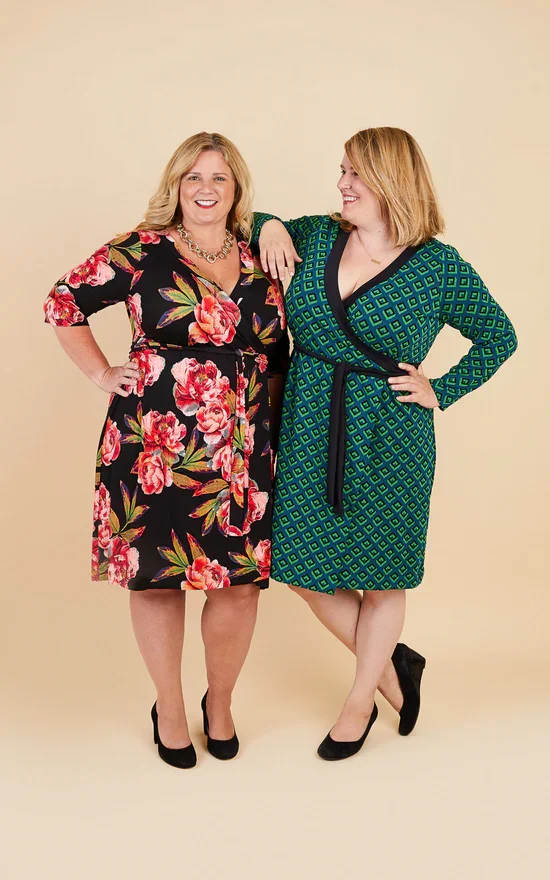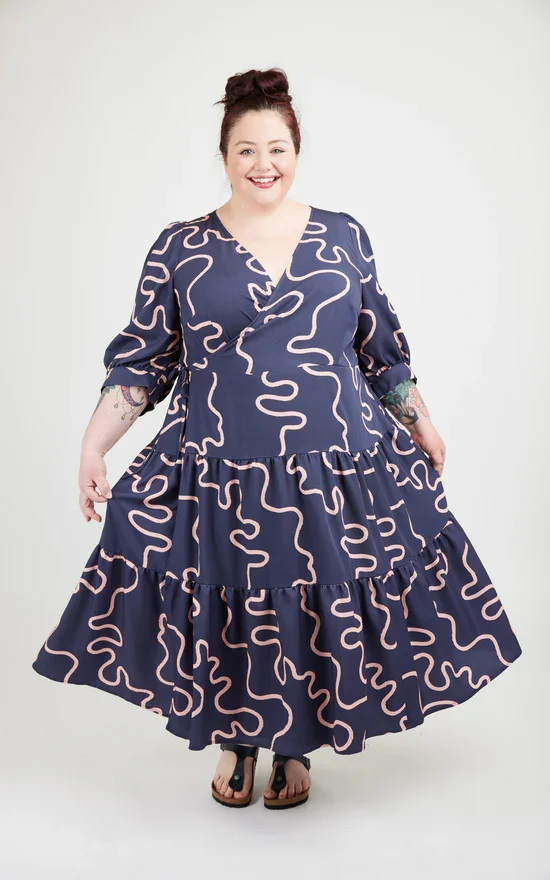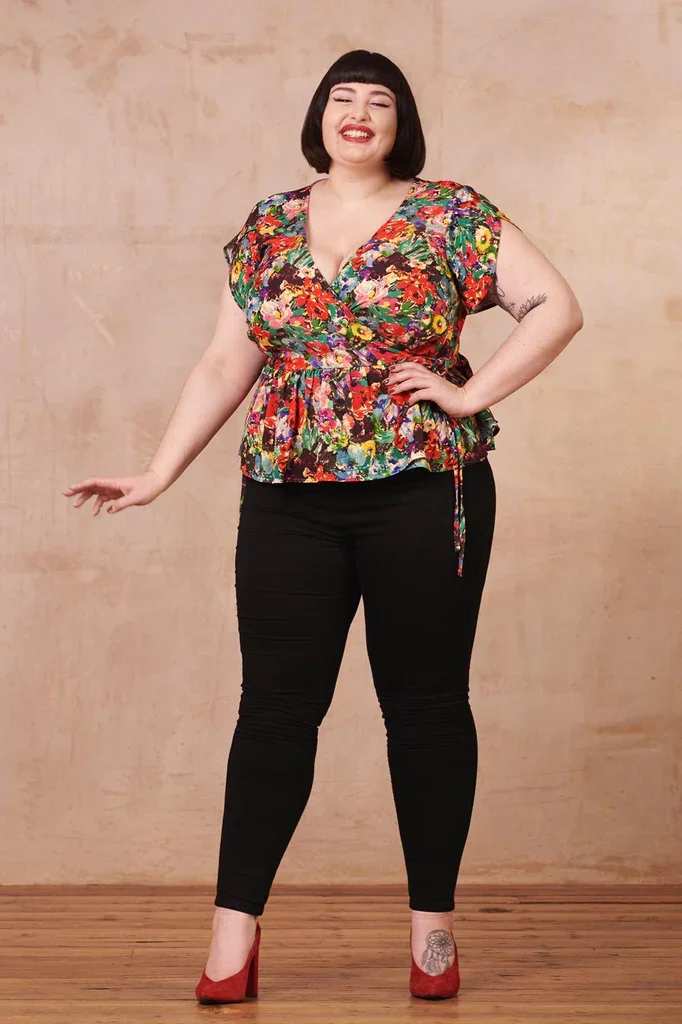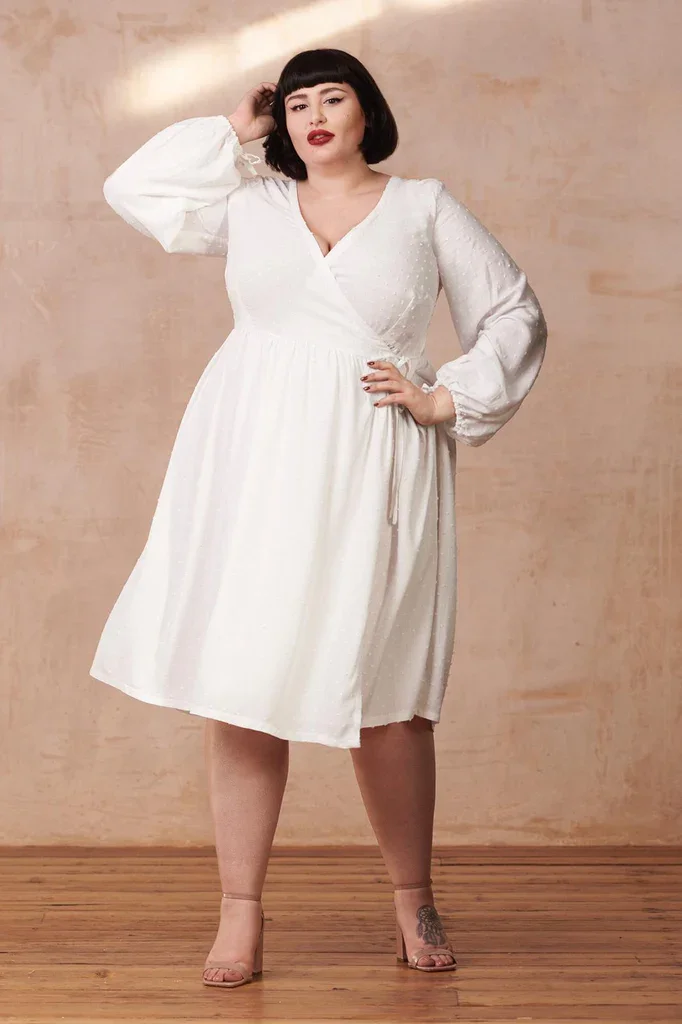Best Size-Inclusive Wrap Dress Sewing Patterns
The Wrap Dress — A Timeless Icon
Few garments have the enduring appeal of the wrap dress. Whether you're after something practical for everyday wear or a comfortable option that still feels put-together, the wrap dress delivers on both style and ease of wear.
The iconic knit wrap dress was designed by Diane von Fürstenberg in 1974. It was an instant hit — it was comfortable, it suited a wide range of bodies, and it was the perfect garment for the growing number of women entering office environments. It offered freedom of movement without compromising on polish, and its influence can still be seen in wrap dress sewing patterns today.
Season 11, Episode 3 of The Great British Sewing Bee featured the DVF wrap dress as its pattern challenge — and I found myself thinking less about the sewing and more about the story behind it. It was fascinating to hear about the origins of this ultimate wrap dress and to learn more about Diane von Fürstenberg herself.
Von Fürstenberg designed the original knit wrap dress fifty years ago, when knits were still a relatively new type of fabric. It’s easy to forget that jersey wasn’t always commonplace in home sewing or ready-to-wear. The wrap dress felt modern because it was — and designed for the lives women were starting to lead in workplaces that hadn’t always welcomed them.
Diane von Fürstenberg discussed the dress’s origin and its broader cultural impact in this Time interview. In the linked article she reflects on how the wrap dress became an emblem of women's liberation and professional presence. It’s worth a read if you’ve ever dismissed the wrap dress as too mainstream or outdated.
What Is a Wrap Dress?
In 1974, when Diane von Fürstenberg designed the first knit wrap dress, she combined a wrap-style top with a skirt in stretchy silk jersey fabric. Her design stood out because knits were still relatively new in ready‑to‑wear, and this garment offered something both bold and practical. Within a year, production had reached 25,000 dresses per week, and she sold over a million by 1976.
A wrap dress crosses the front of the body and has waist ties that are secured at the side or back, forming a deep V-neck front bodice piece and cinching at the waist — a design that makes it adjustable, stylish, and practical. Wrap dresses can be made with woven or knit fabric and are typically categorised as:
True wrap – opens fully and ties around the body
Faux wrap – bodice is sewn closed at the waist, the skirt may have an overlap but cannot be opened at the waist
Surplice bodice – bodice is sewn closed at the crossover and the skirt has no overlap
Each type has its strengths. It depends on what you want from the pattern — adjustability, ease, or stability — and how you like your clothes to behave throughout the day. Typically a true wrap dress that opens fully and has a hole in the side seams for the waist tie to thread through provides the most adjustability but the least stability. If poorly fitted they can gape at the bust, and if the skirt is not very full, it can flap open when walking. A faux wrap still has a crossover at the front, but it's secured at the side seams, so it cannot be adjusted. This is more stable, but it can still gape if not correctly fitted at the neckline. The length of the neckline and the angle of the fronts are critical when sewing this style. A dress with a surplice bodice is the most stable, since the crossover is sewn down and becomes purely visual. There's almost no chance of gaping with this style.
Well-Drafted Wrap Dresses for EVERY Body
Here is a trusted selection of size-inclusive wrap dress patterns for knit and woven fabrics for plus-size sewists with both large and small busts, and of all sewing skill levels.
Ellie and Mac Tres Belle Dress
The Tres Belle is a faux wrap dress designed for knits, with lots of room to customise. It includes short sleeves, long sleeves, tank, and ¾-length options — plus multiple skirt lengths (tunic to maxi) and three skirt shapes: gathered, half circle, and full circle. There's even a top version with built-in pockets for everyday wear.
The pattern goes up to a 63" hip, making it a solid option for anyone looking for a size-inclusive design that doesn’t require major adjustments out of the gate. It’s a PDF pattern with a clear size chart and printable sleeve pieces included. I’ve sewn it multiple times — three dresses and one top — and even hacked it to add a flutter sleeve, which worked beautifully with the surplice bodice shape.
If you’re a confident beginner or it’s your first time sewing with jersey, there’s a video tutorial linked right on the pattern listing that walks you through every step.
I’ve made 4 Tres Belles
My personal favourite knit wrap dress pattern is the Tres Belle. This version is viscose elastane jersey and I’ve chosen the gathered skirt and short sleeves.
Cashmerette Appleton Dress
The Appleton Dress is a true wrap dress designed specifically for curves. It comes in sizes 12–32, with C–H cup options, and includes a unique neckband construction that helps prevent gaping across the bust — a feature Cashmerette is rightly known for. This pattern is available in both PDF and printed formats, and there’s a free step-by-step sewalong on the Cashmerette blog if you prefer extra guidance beyond the printed booklet.
Designed to stay put through daily wear, the Appleton includes thoughtful details like a longer underlap, a built-in tie waist, and multiple sleeve lengths. It’s a solid pick if you’re sewing for a larger bust and want a true wrap dress that doesn’t need adjusting or redrafting. The recommended fabrics are jersey or ITY with at least 50% stretch.
It’s labelled as suitable for advanced beginners, and while I haven’t made this one myself, I’ve heard consistently positive things about its fit and clear instructions — especially for sewists who’ve struggled to find wrap dresses that work with their shape out of the envelope.
Cashmerette Roseclair Dress
If you're looking for a woven wrap dress with thoughtful drafting and multiple style options, the Roseclair is a strong choice. It’s a true wrap with a size range from 0–32 and cup sizes from C to H, designed to reduce neckline gaping through shaping, not compromise.
The pattern includes three views: a tiered maxi with bishop sleeves, a knee-length dress with short sleeves, and one with on-trend puff sleeves. There’s also the option to make a peplum top using just the bodice and upper skirt tier — ideal if you prefer separates or want to test the bodice fit with less fabric than a full dress.
I haven’t made this one myself yet, but I’ve seen some lovely versions in the plus-size sewing community, including a particularly eye-catching one in double gauze. The tiered view is especially popular, and the combination of volume and shaping gives it flexibility across fabric types — from floaty viscose to soft cotton lawn.
The Roseclair is rated for advanced beginners and comes with a free sewalong on the Cashmerette blog for extra support. It’s available in PDF and printed formats, and Cashmerette has a size calculator to help you choose your starting point.
By Hand London Hannah Dress
The Hannah Dress is a woven true wrap with soft shaping, three sleeve options, and enough versatility to shift from daytime to evening depending on your choice of fabric. The pattern includes a gently gathered skirt and your choice of short, petal, or bishop sleeves. It’s unlined and zipper-free, which makes it quicker to sew — especially if you’re working with cottons, chambray, or other structured wovens.
I haven’t made the Hannah yet, but I’ve picked up both the PDF and paper version and am especially looking forward to trying it as a party top with the petal sleeves. It’s one of those patterns that shifts personality completely depending on fabric — I’ve seen it work beautifully in plain and patterned cotton lawn and as an everyday chambray beach dress.
The Hannah comes in two cup blocks — B cup (UK 6–24) and D cup (UK 16–34) — with both print-at-home and copyshop PDFs available. You’ll want to double-check your fabric width if you're sewing the upper size range, as sizes 24–34 are drafted with wider fabric in mind. You can explore the hashtag #bhlHannah on Instagram to see how others have made it their own.
One Pattern, Many Options
Once you’ve found a wrap dress pattern that fits you well, it opens up a lot of creative possibilities. You don’t need a new pattern for every look — just a few ideas and the confidence to tweak what you already have.
Some of the easiest ways to change up a wrap dress include:
Fabric choice - the same pattern made with different fabric will give an entirely different look and feel
Switching up the sleeves — short, long, flutter, or puffed. You can borrow the sleeve and armscye from another pattern or draft your own.
Adding a ruffle hem — for movement and interest. In fact, adding a ruffle to any edge of the dress will work - neckline, wrap edge, hem, sleeve hems. Add to one, or several to create different moods.
Adjusting the skirt length or shape — if the dress has a waist seam it’s easy to switch out the pattern’s skirt for a different style. Try straight, flared, or gathered skirts with a surplice or faux wrap. Or for a true wrap, try a rounded off or squared off overlap for a different look.
Adding a Johnny collar — 'Johnny collar' is the name for the half-collars often found on high-end wrap dresses that go part of the way down the V-neckline and give a shirtwaist look. They can have rounded or pointed tips.
Whether you’re sewing your second wrap dress or your seventh, it’s satisfying to know your go-to pattern can still surprise you with just a few simple tweaks.
Here are some of my other blog posts that you may find relevant:
The Right Tools for the Job
When sewing DVF-style knit wrap dresses, a few thoughtful tools can make the difference between a project that feels a bit gappy and one that looks and wears beautifully.
Framilastic — This is the neckline stabiliser I recommend and the one I actually use. It’s soft, stretchy, and specifically designed for knit fabrics. I use it along the front neckline of wrap bodices to help them keep their shape through wear and washing. It’s also useful at the waist seam — especially if the skirt has any weight to it — as it helps support the fabric and prevents the bodice from being dragged downward. Buy Framilastic from Minerva
Twin needle — If you don’t have a coverstitch machine (and, let's face it, not many of us do) a twin needle is a solid and traditional option for hemming knits. It gives you two neat lines of stitching on the outside, and a tidy zigzag underneath that allows the fabric to stretch. Buy twin needles from Minerva
Dedicated bobbin case for twin needle sewing — One of the best tips I’ve learned: keep a separate bobbin case just for twin needle hems, and loosen the tension slightly. It can make a huge difference to how evenly the stitches form and helps avoid tunnelling — especially in lighter knits. Buy a Metal Bobbin Case from Minerva
These are all small things, but their impact on your sewing adds up. Especially when you’re working with lightweight or slinky knit fabrics that stretch and shift more than wovens. If you’re investing time into sewing a dress you’ll wear often, it’s worth investing in the right tools too.
Where Next?
Wrap dresses are one of those timeless and versatile patterns you come back to. Maybe it's the ease of wear, or the way a small change in fabric or detail creates a completely new look — but once you’ve made one, it rarely stops there.
If this post has sparked some ideas, have a wander through the rest of the blog. You’ll find more posts on fitting, pattern hacks, tools worth knowing about, and a few personal tips that I use again and again. Whether you're planning your next make or just in the mood for a scroll, there's plenty to explore.
Not ready to sew just yet? Save or pin this post so you can find it again later — I’ll still be here when the mood strikes.





